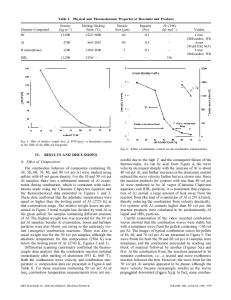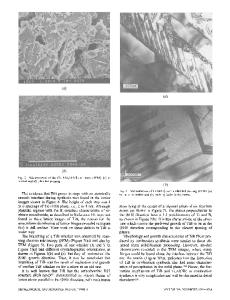The Combustion Synthesis of B 4 C-A1 2 0 3 -Al Composite Materials
- PDF / 1,900,654 Bytes
- 7 Pages / 420.48 x 639 pts Page_size
- 114 Downloads / 354 Views
THE COMBUSTION SYNTHESIS OF B4C-A1 203 -A1 COMPOSITE MATERIALS 1 H. J. Fengi, John J. Moore , and 'Department of Metallurgical of Mines, Golden, Colorado 2 Coors Ceramics Co., Golden,
2 D. G. Wirth and Materials Engineering, Colorado School 80401 Colorado 80401
ABSTRACT The combustion synthesis of the B4 C-2A10 3 -xAl ceramic-metal composite system has been studied using the propagating mode of ignition for the reaction 2Bz0 + C + (4 + x)Al = B4C + 2Al0 3 + xAl in which x was varied between 0 and 3. The volatile constituent(s), eg. BO resulted in the formation of an expanded or foamed ceramic with a uniform porous structure. The porosity represents k65%, and an expansion of 300-500% occurred mainly in the vertical direction. The effect of green density and reaction stoichiometry on product density, pore morphology, propagation rate and overall activation energy is discussed. INTRODUCTION Self-propagating high-temperature (combustion) synthesis (SHS) is capable of producing numerous ceramic-composite materials [1]. SHS involves the ignition of an exothermic reaction in a powder mix at a certain minimum (ignition) temperature, Tig. The reaction generates sufficient heat that it becomes self sustaining. The maximum or combustion temperature, Tc, can be calculated from enthalpy-temperature relationships (Figure 1). Under adiabatic conditions, Tc is called the adiabatic temperature (Tad), Tm
i.e.
Tad
AH(Tad) = AH(Tig) + fACpdT * AH. + fACpdT=0 Tig
(1)
TM
Where Tm is a transformation temperature, eg. melting, through which the reactants or products may go, and AHmthe associated enthalapy change, ACp is the change in heat capacity. The major disadvantage of SHS-produced materials is the high level of porosity, i.e. !50%. However, this porosity can be used to advantage in producing foamed or expanded ceramic materials [2]. The expanding SHS reaction system investigated is 2B 03 + C + (4 + x)Al = B4 C + 2A1 203 + xAl. An excess amount of Al, (ie. xAi) is used to provide improved mechanical properties. The excess liquid Al infiltrates the pores, providing a ductile network within the B4C-A1203 matrix. EXPERIMENTAL PROCEDURE Graphite (-44gm), B 0 (-75Sum) and Al (-44pm) powders were milled for 4 hours and pressed into pell ets (13mm diameter X 26mm) of various green densities and a range of values of excess Al(xAl), i.e. x = 0, 1, 2, 3. These pellets were then ignited using an electrically heated tungsten filament in an argon atmosphere. The combustion wave front was recorded using a video camera. Tig and Tc were determined using a Pt-Pt/10% Rh and W-W/5% Re thermocouples and an Ircon Mirage two wave length infrared pyrometer. The products were characterized using optical and scanning Mat. Res. Soc. Symp. Proc. Vol. 249. @1992 Materials Research Society
530
2000
0
5. -2000
zo P, -4000
1000
0
Figure 1 -
2000 TEMPERATURE
3000
4000
(K)
H-T plot for reactants (Xr)
and
products (Xp) 0.8 •X=O
•x=1 0.7 z
09 X=2
i
|
i
I
i
0.6
0 IE0O7 2E+07 3E+07 4E+07 53E07 63+07 7E07 PRESSURE APPLIED TO GREEN PELLETS
Data Loading...











